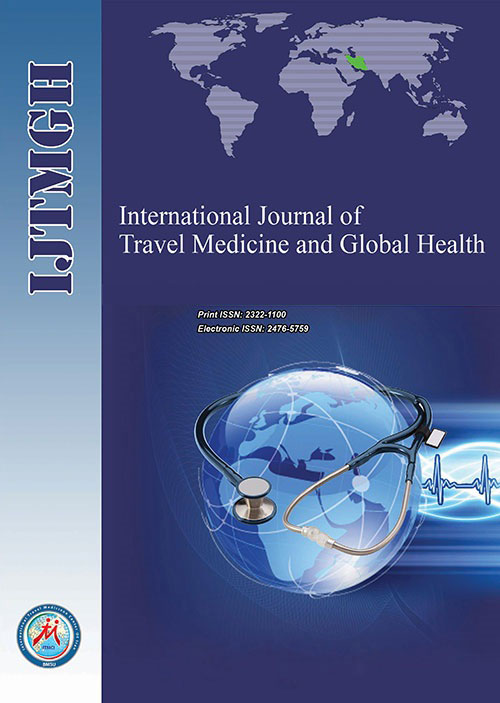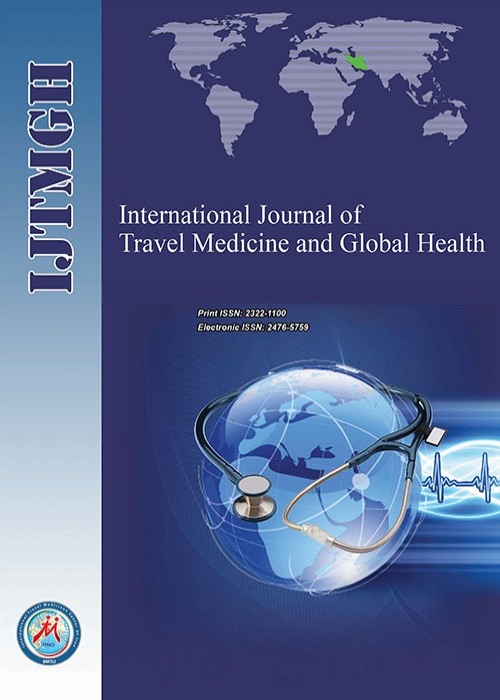فهرست مطالب

International Journal of Travel Medicine and Global Health
Volume:10 Issue: 1, Winter 2022
- تاریخ انتشار: 1401/04/10
- تعداد عناوین: 8
-
-
Pages 1-3Extreme aerial sports are unique in terms of their high degree of lethality, life-changing injuries, and the lack of experience required by amateur participants. As society gradually re-emerges from the pandemic, we are likely to witness a renewed interest in outdoor adventure activities, including extreme aerial sports such as bungee jumping and skydiving. Sports physicians, general practitioners and travel medicine advisers should have a basic familiarity with the risks associated with bungee jumping and skydiving. Serious injury can occur during bungee jumping when the safety harness fails, the cord elasticity is miscalculated, or the cord is not properly connected to the platform. There is a predominance of ocular injuries, especially retinal haemorrhage. More severe non-fatal injuries include facet joint dislocation with quadriplegia, carotid artery dissection, and non-fatal hanging. The majority of adverse skydiving incidents occur during the landing phase and most injuries involve the lower extremities. When travelling as a skydiving tourist, individuals should carry documents explaining each aspect of the equipment and a note for security personnel. Tourists should check if their insurance covers skydiving. Future research should investigate the experiences of aerial sports tourists, in relation to the level of preparation and safety measures applied to their jumps.Keywords: Sports Tourism, adventure tourism, Travel Health, Trauma, extreme sports
-
Pages 4-9
Every year, the number of people using commercial aircraft is estimated at two billion, and more than 300 million people take long-haul flights. Sickle cell patients may be at risk during the air journey because significant hypobaric hypoxia may occur at cruising altitude. This literature review reports complications related to air travel such as painful crises, serious spleen complications (spleen infarcts) requiring a splenectomy, or even sudden death. Prevention of these complications includes environmental protection (maintaining pressure inside the aircraft cabin in a hypobaric condition) and individual prophylaxis (general recommendations for all travelers and specific measures for sickle-cell patients). In order to assess complications associated with air travel in sickle-cell patients, an assessment of their ability to fly is necessary. In addition, the flight fitness assessment identifies patients who will need additional oxygen during flight. When prescribed by the passenger’s physician, additional oxygen is provided by most airlines. Knowing these elements makes it possible to anticipate problems and provide appropriate responses to patients.
Keywords: air travel, Sickle cell disease, hypoxia, Altitude -
Pages 10-15IntroductionA cluster of novel coronavirus disease 2019 (COVID-19) linked to an international traveller was reported in Kedah, Malaysia in July 2020. This study aimed to report data of a local community cluster of COVID-19 with a view to document the lessons learnt and to identify key points for future containment strategy in response of the ongoing pandemic.MethodsEpidemiological and clinical data from individuals with confirmed cases of COVID-19 within this cluster were collected via interviews and in-patient medical records. All data were analysed, and socio-demographic and clinical characteristics of all cases were presented.ResultsTotal of 31 cases of COVID-19 were confirmed and linked epidemiologically in Kedah state. The index case was identified and reported to breach quarantine order for international traveller given by health authority. The virus transmission widely spread among family members, restaurant customers and later in the community.ConclusionNon-adherence to the preventive measures is the driving factor for the widespread of this cluster infection. Active contact tracing, aggressive containment measures, and effective risk communication are important to control the virus transmission in this locality.Keywords: COVID-19 virus infection, Disease Outbreaks, health communication, infectious disease transmission, quarantines
-
Pages 16-23IntroductionWhile socioeconomic status (SES) indicators such as household income are known to be associated with larger cortical surface area, recent research on Marginalization-related Diminished Returns (MDRs) suggests that family SES indicators such as household income may have weaker effects on brain function and structure for non-White (marginalized) than White (privileged) families: a pattern that reflects structural and societal inequalities deeply intertwined into the United States social fabric.MethodsThis is a cross-sectional study that used baseline data from the Adolescent Brain Cognitive Development (ABCD) study. Data was collected between 2016 and 2018. Overall, 6039 9–10-year-old children entered our analysis. The independent variable was household income. The moderator was race. The primary outcome was the overall cortical surface area. Age, sex, and family structure were the covariates. We used mixed effects regression models that adjusted for data analysis because ABCD data is nested into families, centers, and US states.ResultsWhile high household income was associated with larger cortical surface area, this effect was weaker for Asian than non-Hispanic White children. This racial heterogeneity in the effects of household income on cortical surface area was documented by a statistically significant interaction between race and household income on cortical surface area.ConclusionFor American children, household income does not similarly correlate with cortical surface area of diverse racial groups. Brain development in the US is not solely a function of SES (availability of resources) but also how social groups are racialized and treated in the society. In the US, race, as a proxy of racism, limits how much SES can affect brain structures such as cerebral cortex. Due to racialization, segregation, discrimination, and marginalization, racial minority children may experience weaker effects of SES. Structural inequalities should be addressed to equalize the return of SES resources across racially diverse families.Keywords: Immigration, Health, brain development
-
Pages 24-31IntroductionOne of the largest religious gatherings in the world is the Arbaeen pilgrimage, which takes place on the 40th day after the anniversary of the martyrdom of Imam Hussein, the third Shiite Imam. This study was aimed to investigate how to set up the Sahib-al-Zaman treatment camp on the Arbaeen walking route in 2019 and the patients referring to it.MethodsThis retrospective cross-sectional study was conducted on all patients referring to the Sahib-al-Zaman camp of Shiraz University of Medical Sciences, Shiraz, Iran in the Arbaeen Walking plan in 2019. In this study, how to set up camp was described. Patients’ data and drugs used by the medical team were collected, and then were analyzed.ResultsTotally, 3477 patients were enrolled. The mean ± SD of patients’ age was 33.77 ± 16.19 (ranging from 1 to 96) years, and 2,183 patients (62.78%) were male. Most patients were Iranian (84.5%) and then Iraqi (13.66%), and only 1.84% were from other nationalities. Upper respiratory tract infection (60.2%), low back pain and muscle cramps (17.6%), and blister and need for dressing (12.3%) were the most common chief complaints in the patients. Adult cold pills, acetaminophen (325 mg), and cetirizine (10 mg) were the most commonly prescribed drugs for the patients.ConclusionAlthough the data used in this study are not sufficient due to the lack of a pre-created data recording system, the results of this study showed that in addition to the importance and necessity of holding such ceremonies, health issues and facilities should also be considered.Keywords: Communicable diseases, health policy, Noncommunicable Diseases, public health, Travel Medicine
-
Pages 32-39IntroductionMedical tourism is developing more rapidly, particularly in developing countries, as a tool to enhance economic growth and achieve a competitive position. The present study aims to investigate and identify contributory factors to the competitiveness of Iran’s medical tourism using importance-performance analysis.MethodsThis is an applied study with a descriptive nature conducted using field studies and surveys. A conceptual model was adopted and contributory factors were extracted from previous studies. A questionnaire was designed based on extracted factors and opinions of experts who are specialists in the field of medical tourism. The statistical population consisted of tourism experts, health experts, physicians, and medical staff working in hospitals with international units. Data analysis was performed using SPSS.ResultsThe results showed that “medical services” were more important than the two components “special factors of tourism” and “characteristics of medical tourism destinations”. It was also revealed that the current situation of “medical tourism destination characteristics” is unfavorable compared to the other two components.ConclusionThis study provided an insight into the importance and quality of performance of the factors affecting the competitiveness of medical tourism, which can be beneficial for managers and planners in Iran and other medical tourism destinations.Keywords: Medical tourism, Competitiveness, Importance-performance analysis, Iran
-
Pages 40-43Introduction
Kleine-Levin syndrome (KLS) is a rare disorder often associated with recurrent hypersomnia, first described by Klein in 1925 but named in 1942 by Critchley and Hoffman. KLS is more common in adolescence and is also more common in men than women. It must be distinguished from repetitive depressive disorder, or psychotic disorder.
Case PresentationIn this report, we present a 27-year-old woman with KLS who showed symptoms such as overeating and mood changes, unwillingness to talk to anyone, and a sedentary lifestyle. Meanwhile, during these periods, other symptoms such as lack of speech, decreased energy, lethargy, and slowness of mental and mood movements were observed in the patient. Eventually, with lithium consumption, her symptoms improve significantly. However, the exact cause of this syndrome and its definitive treatment is still unknown and will require further reports and studies.
ConclusionAccording to the reported case, KLS may be triggered by travel and migration, and in such a situation, may respond well to lithium.
Keywords: insomnia, Travel, Lithium, sleep


